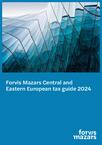Forvis Mazars Central and Eastern European tax guide 2024
This guide, which has grown from covering 15 countries in 2013 to 25 in 2024, delves into a broad spectrum of tax issues, focusing on corporate income taxation, transfer pricing, employment, and sales taxes.
The 2024 guide offers a detailed analysis of tax regimes across a range of countries including Central and South-Eastern Europe, Germany, Austria, Moldova, Ukraine, the Baltic States, and for the 2nd time, Central Asian countries such as Kazakhstan, Kyrgyzstan, and Uzbekistan.
In the first section, the tax systems of the CEE region are presented country-by-country, based on data provided by the relevant Forvis Mazars offices. The end of this guide contains summary tables that allow side-by-side comparisons of the relevant tax environments.
The primary aim of the publication is to allow for comparisons to be made between the fundamental factors of competitiveness in the region.
Key findings:
- The recent focus in the tax landscape has primarily revolved around the implementation of Pillar 2 regulations, specifically the adoption of global minimum tax rate set at 15%. While Serbia has signed the Directive, the Serbian Ministry of Finance has yet to decide on the specific steps for implementing these changes and their impact on existing tax benefits.
- Changes to the Serbian Electronic Invoice System (SEF) have been announced, aiming for the ultimate goal of generating VAT returns electronically directly from the SEF system. Starting September 2024, updates on the input VAT recording process and the alignment of SEF with customs regulations are expected. These developments are forecasted to bring positive outcomes, including a reduction of the grey economy in Serbia and simplifying VAT return and accompanying records preparation. Additionally, they are expected to improve and accelerate tax inspections conducted by the Tax Authorities.
- The Tax Administration in the Republic of Serbia is intensifying efforts to enhance risk analysis criteria during audits, resulting in fewer but more effective tax inspections. This trend has contributed to a 124.2% increase in budget revenue collection under the Tax Administration's jurisdiction from 2014 to 2023. Ultimately, this trend is anticipated to continue, especially with the utilization of e-fiscalization and e-invoicing.
We hope and trust that our readers will find this summary useful and inspiring. We also included the contact information for Forvis Mazars offices and experts.
Download the guide and a brief press release by clicking the link below.
Forvis Mazars CEE Tax Guide 2024 - pdf version
Please visit the interactive online platform of the Forvis Mazars CEE Tax Guide 2024:
Forvis Mazars Central and Eastern European Tax Guide 2024- online tool

